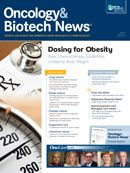Publication
Article
Extending Adjuvant Chemotherapy Offers No Additional Benefit in Low-Risk Primary Breast Cancer
Author(s):
Six cycles of doxorubicin and cyclophosphamide or single-agent paclitaxel do not lead to a superior outcome versus four cycles as adjuvant chemotherapy in women with resected primary breast cancer.
Lawrence N. Shulman, MD
Six cycles of doxorubicin and cyclophosphamide or single-agent paclitaxel do not lead to a superior outcome versus four cycles as adjuvant chemotherapy in women with resected primary breast cancer, according to the results of the phase III CALGB 40101 study. The data showed that six cycles of therapy was not better than four cycles for either relapse-free survival (RFS) or overall survival (OS).
Lawrence N. Shulman, MD, chief medical officer at Dana-Farber Cancer Institute in Boston, Massachusetts, and colleagues elsewhere randomized women with operable breast cancer and zero to three positive nodes to four or six cycles of either doxorubicin/cyclophosphamide or paclitaxel over a 6-year period. The analysis included 3171 patients (Table) who were followed for a median of 5.3 years. Of study participants, 94% were node-negative and 6% had one to three positive nodes.
The optimal duration of adjuvant chemotherapy in women with low-risk primary breast cancer has not been identified, Shulman et al noted. Several studies that have examined adjuvant therapy in this group of women have compared four cycles versus four cycles or six cycles versus six cycles of different regimens. However, none of these studies has compared four cycles versus six cycles of therapy of the same regimen using the identical dose per cycle and schedule of treatment, which would eliminate the potential for a confounded result.
Table. Patient Characteristics in CALGB 40101 Study*
Characteristic
Percentage
Age ≥50 years
59%
Nonwhite
15%
Premenopausal
44%
Node-negative
94%
Tumor size ≤2 cm
64%
ER-positive tumors
64%
HER2-negative tumors
77%
High grade
47%
*N = 3171 patients
Results showed a 4-year RFS of 90.9% in women who received six cycles of therapy and 91.8% in women receiving four cycles. The adjusted hazard ratio (HR) of six to four cycles for RFS was 1.03 (95% CI, 0.84-1.28; P = .77). The 4-year OS was 95.3% and 96.3% in the two groups, respectively, and the adjusted HR of six to four cycles for OS was 1.12 (95% CI, 0.84-1.49; P = .44).
Unplanned subset analyses based on ER and HER2 status revealed no interaction between the number of cycles of therapy and either of these variables. The finding suggests a lack of benefit for any subgroup with a longer duration therapy, the authors noted.
The researchers are still conducting a separate analysis comparing four cycles of doxorubicin/ cyclophosphamide with four cycles of paclitaxel. Until the results are available, the authors wrote that singleagent paclitaxel should not be considered a standard regimen for women with relatively low-risk primary breast cancer.
Shulman LN, Cirrincione CT, Berry DA, et al. Six cycles of doxorubicin and cyclophosphamide or paclitaxel are not superior to four cycles as adjuvant chemotherapy for breast cancer in women with zero to three positive axillary nodes: Cancer and Leukemia Group B 40101 [published online ahead of print July 23, 2012]. J Clin Oncol. doi:10.1200/JCO.2011.40.6405.










